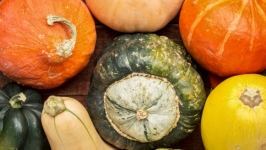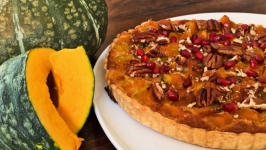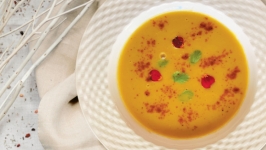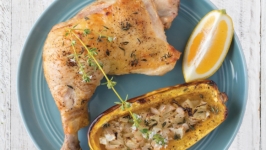A Bay Area Guide to Picking and Preparing Winter Squash This Fall
There’s something about the cooler weather and shorter days of fall that draws us to the beguiling displays of winter squash with their voluptuous shapes, bright colors and textures, promising a warm hearty soup or savory side. With hundreds of edible squash varieties available, squash is one of the most widely grown crops in the United States today, and the Bay Area puts this cornucopia on display beginning in fall through winter. What’s more, small local farmers continually bring lesser-known types to market, captivating and confusing shoppers all at once.
Should you stick with the butternut, a perennial favorite, or venture outside of your comfort zone and try that warty-looking green squash that you have no idea how to use? How can the beautiful striped carnival squash you’ve placed on your table centerpiece be served up in your next meal?
Let’s take a tour of selecting, storing and cooking what is called “winter squash,” along with some insights from local farmers who know best. This season we get help from John Muller, Daylight Farms and Farmer John's in Half Moon Bay; Greg Beccio, owner of Happy Boy Farms in Soquel; and Dru Rivers of Full Belly Farm in CaPay Valley. All of these farms and growers sell and distribute through local farmers markets and community markets, as well as some offer CSA and other distribution.
Native American Roots
Ever wonder why winter squash is readily available in the fall, and why it is called winter squash? The reality is there are only two named categories of squash: summer squash and winter squash.
The terms summer and winter squash originated from the Native Americans, who knew that the seasons were critical to growing foods that could sustain them through the long winter months. Summer squash with its thinner skin and lighter flesh has a shorter season and shelf life—think green and yellow zucchini, pattypan and crookneck. The denser, hard skinned “winter squash” varieties such as butternut, acorn and spaghetti are harvested in the late summer and fall and can be kept and eaten for as long as six months!
A Nutritious and Versatile Fruit
Yes, squash is a fruit! Fruits contain seeds and develop from the flowers of a plant, and this is true of all types of squash. And they are really good for you.
Most winter squash qualifies as a superfood, rich in antioxidants as well as vitamin C and the minerals calcium, magnesium and potassium. They are low in fat and calories and have complex carbohydrates, naturally occurring sugars that provide our bodies with energy and give the sweetness to the squash.
Understanding the versatility of winter squash makes it even more compelling. The moderate sweetness of squash makes it suitable for both savory and sweet preparations and its mild flavor stands up to a wide spectrum of seasoning without overwhelming other ingredients. Preparation and cooking methods of various squash are similar, making the different varieties interchangeable.
Selection and Storage
In selecting your winter squash, you'll want to keep a few things in mind:
“Regardless of variety, winter squash should be hard and free of bruises, and soft spots. When squash feels light and sounds hollow when tapped, you know there is little inside. The stem should be brown (not green) and attached to the squash, a sign the squash has cured on the vine and is ready to eat.”
—Greg Beccio, owner, Happy Boy Farms
As for storage, Native Americans counted on the winter squash they harvested in the Fall keeping for a long time, and you can count on an extended shelf life too for most varieties. If you’ve driven to a farmers market that’s not close to home, you can stock up on all those enticing varieties and take your time figuring out how you want to prepare that squat little kabocha you’ve never tried before. Kept in relatively dry conditions at a temperature of approximately 55°F, winter squash will last 30 to 180 days.
Before storing, clean the surface of the squash with a clean damp cloth and then dry it. Squash that has been cut can be kept in sealed bags in the refrigerator for up to five days. If the squash is cooked or puréed, it can be frozen for up to three months.
In the Kitchen
“Once customers understand winter squash are for cooking and not just ornamental pumpkins, they want to know how to peel, cut and cook them. The more we can educate them on the many ways winter squash can be used, the better!”
—Dru Rivers, co-owner, Full Belly Farm
So let's get cooking!
Winter squash stand up well to all cooking methods: as a roasted vegetable, fried, grilled or used as a base for soups. The seeds of the squash are edible and the shoots and tendrils can be eaten as greens in a salad or used as an aromatic in stocks. Before cooking, you have to cut the squash and remove the fiber and seeds, which can be daunting.
Winter squash have a hard skin and flesh requiring a heavy chef’s knife or cleaver. Whack off the stem with the dull side of a knife. Insert the knife where the stem was and pull it towards you using a rocking motion. Loosen the knife and repeat until the squash is cut. At this point you can remove the seeds.
The easiest way to peel a squash is to bake squash halves, flesh side down on a rimed baking sheet at 375°F for 30–40 minutes or until the flesh is tender. The skin will peel off easily, allowing you to scoop out the cooked flesh. For recipes that require peeling before cooking, use a vegetable peeler to remove the skin.
When steaming squash, the quantity of water should be kept small to avoid losing flavor and nutrients. Cut the squash into quarters or chunks and barely cover with water. The squash will be tender in approximately 25 minutes. Once cooked, squash can be puréed in a food processor or blender and frozen or used in place of canned pumpkin.
Fall into Flavor
“In January and February, farmers talk to seed producers to learn and share about unique squash varieties being grown. We are all searching for that ‘black pumpkin’ that will be the most beautiful, durable and flavorful squash yet.”
—John Muller, Daylight Farms and Farmer John’s
Squash is a cornerstone of fall menus—soups, casseroles, pastas and stuffing. Flavors range from mild to sweet, and are delicate enough they won’t overwhelm other ingredients. The orange and yellow flesh helps brighten dishes—a bonus in the colder months when color can be hard to come by in seasonal produce. And don’t be daunted by winter squash’s size, heft and tough exterior; you can sometimes find popular varieties cut in half or already peeled and cubed in local community markets.
Now is the time to begin your exploration of squash into butternut and beyond. Enjoy!






